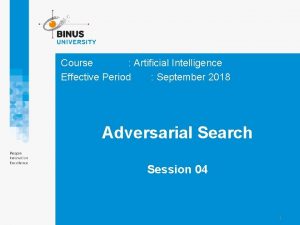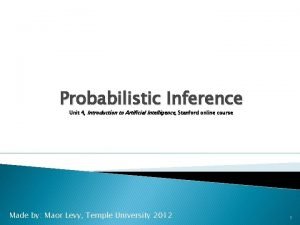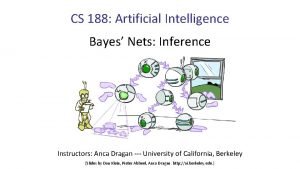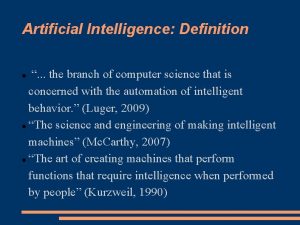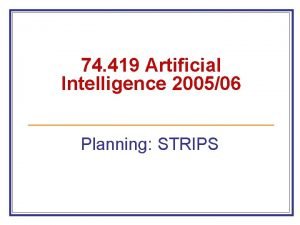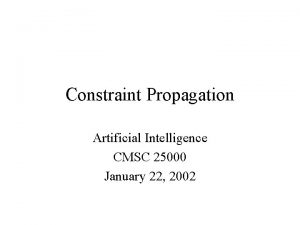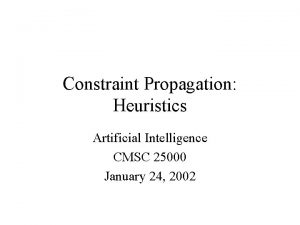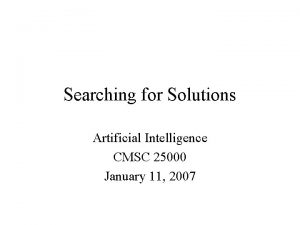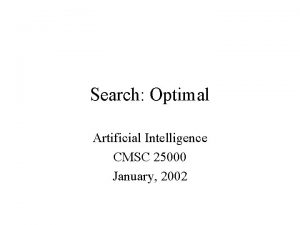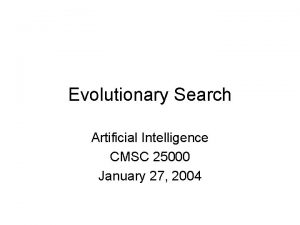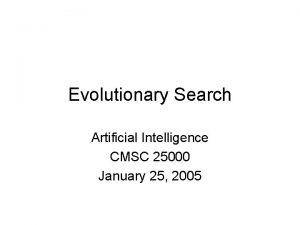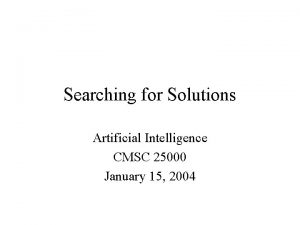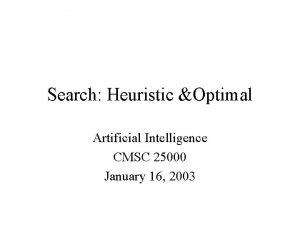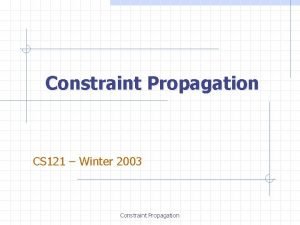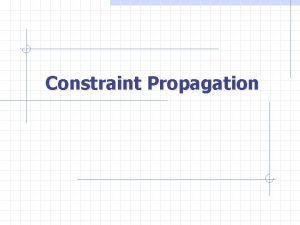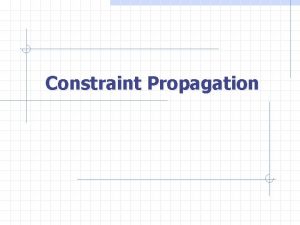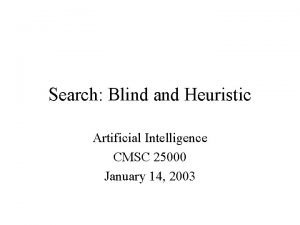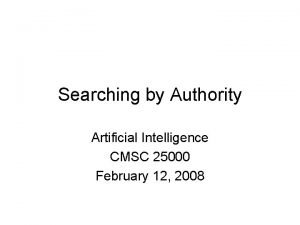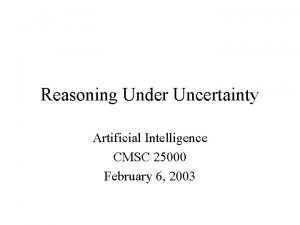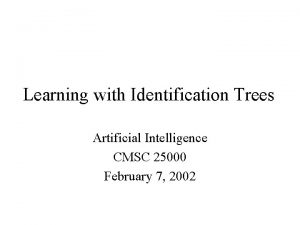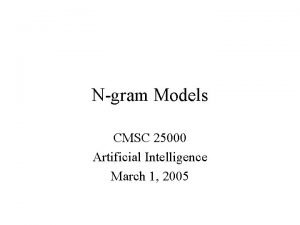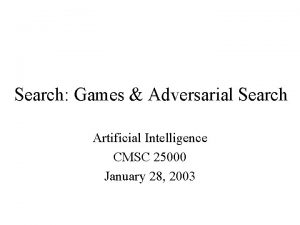Constraint Propagation Artificial Intelligence CMSC 25000 January 21



































- Slides: 35

Constraint Propagation Artificial Intelligence CMSC 25000 January 21, 2003

Agenda • Constraint Propagation: Motivation • Constraint Propagation Example – Waltz line labeling • Constraint Propagation Mechanisms – Arc consistency – CSP as search • Forward-checking • Back-jumping • Summary

Constraint Satisfaction Problems • Very general: Model wide range of tasks • Key components: – Variables: Take on a value – Domains: Values that can be assigned to vars – Constraints: Restrictions on assignments • Constraints are HARD – Not preferences: Must be observed • E. g. Can’t schedule two classes: same room, same time

Constraint Satisfaction Problem • Graph/Map Coloring: Label a graph such that no two adjacent vertexes same color – Variables: Vertexes – Domain: Colors – Constraints: If E(a, b), then C(a) != C(b)

Constraint Satisfaction Problems • Resource Allocation: – Scheduling: N classes over M terms, 4 classes/term – Aircraft at airport gates • Satisfiability: e. g. 3 -SAT – Assignments of truth values to variables such that 1) consistent and 2) clauses true

Constraint Satisfaction Problem • “N-Queens”: – Place N queens on an Nx. N chessboard such that none attacks another – Variables: Queens (1/column) – Domain: Rows – Constraints: Not same row, column, or diagonal

N-queens Q 3 Q 1 Q 4 Q 2

Constraint Satisfaction Problem • Range of tasks: – Coloring, Resource Allocation, Satisfiability – Varying complexity: E. g. 3 -SAT NP-complete • Complexity: Property of problem NOT CSP • Basic Structure: – Variables: Graph nodes, Classes, Boolean vars – Domains: Colors, Time slots, Truth values – Constraints: No two adjacent nodes with same color, • No two classes in same time, consistent, satisfying ass’t

Constraint Propagation Method • For each variable, – Get all values for that variable – Remove all values that conflict with ALL adjacent • A: For each neighbor, remove all values that conflict with ALL adjacent – Repeat A as long as some label set is reduced

Constraint Propagation Example • Image interpretation: – From a 2 -D line drawing, automatically determine for each line, if it forms a concave, convex or boundary surface – Segment image into objects • Simplifying assumptions: – World of polyhedra • No shadows, no cracks

CSP Example: Line Labeling • 3 Line Labels: – Boundary line: regions do not abut: > • Arrow direction: right hand side walk – Interior line: regions do abut • Concave edge line: _ • Convex edge line : + • Junction labels: – Where line labels meet

CSP Example: Line Labeling • Simplifying (initial) restrictions: – No shadows, cracks – Three-faced vertexes – General position: • small changes in view-> no change in junction type • 4^2 labels for 2 line junction: L • 4^3; 3 -line junction : Fork, Arrow, T • Total: 208 junction labelings

CSP Example: Line Labeling • Key observation: Not all 208 realizable – How many? 18 physically realizable All Junctions L junctions + _ Fork Junctions + + _ _ T junctions + _ + _ _ Arrow junctions + _ _ _+ _ +

CSP Example: Line Labeling • Label boundaries clockwise • Label arrow junctions + + +

CSP Example: Line Labeling • Label boundaries clockwise

CSP Example: Line Labeling • Label fork junctions with +’s + + + +

CSP Example: Line Labeling • Label arrow junctions with -’s + + _ _ + + + _ + +

Waltz’s Line Labeling • For each junction in image, – Get all labels for that junction type – Remove all labels that conflict with ALL adjacent • A: For each neighbor, remove all labels that conflict with ALL – Repeat A as long as some label set is reduced

Waltz Propagation Example C X D X B A X

Waltz’s Line Labeling • Full version: – Removes constraints on images • Adds special shadow and crack labels • Includes all possible junctions – Not just 3 face • Physically realizable junctions – Still small percentage of all junction labels – O(n) : n = # lines in drawing

Constraint Propagation Mechanism • Arc consistency – Arc V 1 ->V 2 is arc consistent if for all x in D 1, there exists y in D 2 such that (x, y) is allowed • Delete disallowed x’s to achieve arc consistency

Arc Consistency Example • Graph Coloring: • Variables: Nodes • Domain: Colors (R, G, B) • Constraint: If E(a, b), then C(a) != C(b) • Initial assignments Y X Z

Arc Consistency Example Arc X -> Y X -> Z Y-> Z X -> Y Rm Value None X=B Y=B X=R X -> Z Y -> Z None Y ======> Assignments: X=G Y=R Z=B X Z

Limitations of Arc Consistency X • Arc consistent: – No legal assignment • Arc consistent: Z Y – >1 legal assignment X Y Z

CSP as Search • Constraint Satisfaction Problem (CSP) is a restricted class of search problem – State: Set of variables & assignment info • Initial State: No variables assigned • Goal state: Set of assignments consistent with constraints – Operators: Assignment of value to variable

CSP as Search • Depth: Number of Variables • Branching Factor: |Domain| • Leaves: Complete Assignments • Blind search strategy: – Bounded depth -> Depth-first strategy • Backtracking: – Recover from dead ends – Find satisfying assignment

CSP as Search No! No! No! Yes!

Backtracking Issues • CSP as Search – Depth-first search • Maximum depth = # of variables – Continue until (partial/complete) assignment • Consistent: return result • Violates constraint -> backtrack to previous assignment – Wasted effort • Explore branches with no possible legal assignment

Backtracking with Forward Checking • Augment DFS with backtracking – Add some constraint propagation • Propagate constraints – Remove assignments which violate constraint – Only propagate when domain = 1 • “Forward checking” • Limit constraints to test

Backtracking+Forward Checking No! Yes!

Heuristic CSP • Improving Backtracking – Standard backtracking • Back up to last assignment – Back-jumping • Back up to last assignment that reduced current domain • Change assignment that led to dead end

Heuristic CSP • Backtracking – Pick “first”/”leftmost” node to expand • Heuristic CSP – Most constrained variable: • Minimize branching factor – Least constraining value: • Pick value that removes fewest values from other vars • Improve chance of finding SOME assignment • Can increase feasible size of CSP problem

Iterative Improvement • Alternate formulation of CSP – Rather than DFS through partial assignments – Start with some complete, valid assignment • Search for optimal assignment wrt some criterion • Example: Traveling Salesman Problem – Minimum length tour through cities, visiting each one once

Iterative Improvement Example • TSP – Start with some valid tour • E. g. find greedy solution – Make incremental change to tour • E. g. hill-climbing - take change that produces greatest improvement – Problem: Local minima – Solution: Randomize to search other parts of space • Other methods: Simulated annealing, Genetic alg’s

CSP Summary • General problem structure – Variables; Domain: values to assign; – Constraints: Restrictions on valid assignments – N-Queens; Graph-coloring; 3 -Sat; Scheduling • Constraint propagation mechanisms – Arc consistency – Search model: Backtrack+Forward-checking • Heuristics: Back-jump; Variable&value selection – Iterative improvement reformulation
 750000/25000
750000/25000 61000-25000
61000-25000 750000/25000
750000/25000 Suctorios
Suctorios 25000-7000
25000-7000 Iso 25000
Iso 25000 References for artificial intelligence
References for artificial intelligence Ethics of artificial intelligence
Ethics of artificial intelligence 8 emerging technologies
8 emerging technologies Optimal decisions in games in artificial intelligence
Optimal decisions in games in artificial intelligence Ao * algorithm
Ao * algorithm Knowledge manipulation in artificial intelligence
Knowledge manipulation in artificial intelligence Artificial intelligence
Artificial intelligence Inference by enumeration in artificial intelligence
Inference by enumeration in artificial intelligence A programmable electronic device designed to accept data
A programmable electronic device designed to accept data Informed and uninformed search
Informed and uninformed search Artificial intelligence applications institute
Artificial intelligence applications institute Math and artificial intelligence
Math and artificial intelligence Inference by enumeration in artificial intelligence
Inference by enumeration in artificial intelligence Artificial intelligence applications institute
Artificial intelligence applications institute Artificial intelligence devices
Artificial intelligence devices Artificial intelligence is a branch of computer science
Artificial intelligence is a branch of computer science Unit 7 artificial intelligence
Unit 7 artificial intelligence Artificial intelligence devices
Artificial intelligence devices Uas kecerdasan buatan
Uas kecerdasan buatan Optimal decisions in games in artificial intelligence
Optimal decisions in games in artificial intelligence Coordinated plan on artificial intelligence
Coordinated plan on artificial intelligence Strips planning example
Strips planning example Importance of turing test in artificial intelligence
Importance of turing test in artificial intelligence Prolog iterative deepening search
Prolog iterative deepening search Problem solving by searching in artificial intelligence
Problem solving by searching in artificial intelligence Fuzzy propositions in artificial intelligence
Fuzzy propositions in artificial intelligence Artificial intelligence chapter 1
Artificial intelligence chapter 1 Types of agents in artificial intelligence
Types of agents in artificial intelligence Part picking robot peas
Part picking robot peas Propositional logic in ai ppt
Propositional logic in ai ppt









